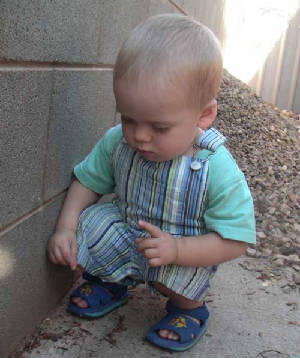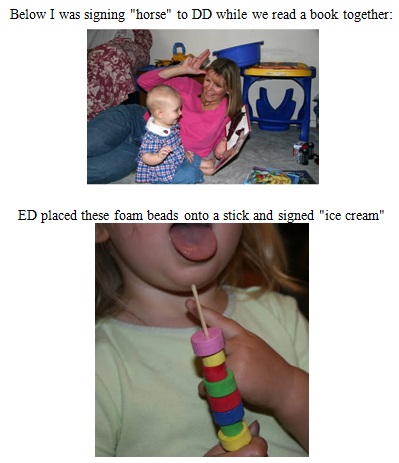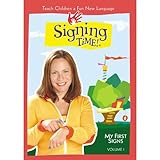Signing with Babies and Toddlers (Baby Sign Language)
Signing with Your Baby and Toddlers
Baby Signing — Our family decided to sign with each of our babies/tots. Our children all had normal hearing, but I learned that kids could control their hands and fingers and could therefore communicate by sign much earlier than with speech. It seemed like a good idea and most of my friends were doing simple signs with their babies/tots too. We were SO glad that we did because our kids each developed quite a large signing vocabulary and could communicate by sign months before they were able to speak those same words.
Why sign with babies? Well, for one thing it’s fun and it creates a wonderful bond between parent and baby. It is interactive and allowed us to communicate with our babies/toddlers (and them with us) at a younger age. It can also help with baby’s frustration at this young age. By being able to sign simple things like drink or all done, babies and toddlers can express their needs (or desires). Hand-eye coordination develops much earlier than verbal abilities. Babies who sign often speak earlier and may improve language and vocabulary. Sign has also been found to be helpful for kids with developmental delays.
Benefits of Baby Sign Language — Wikipedia explains that in a study done with young children who signed (and those who didn’t), those who signed had a significant developmental advantage:
An American team led by Drs. Linda Acredolo and Susan Goodwyn studied 11-month-old children. The children were assigned into two groups in this study; the first group consisted of children that used Baby Sign Language and the second group consisted of children that did not use Baby Sign Language. Up until the age of three, the children’s speech and language development was monitored. Results showed that the average scores of children in the study that were in the group that used Baby Sign Language were found to be higher than the control group who did not use Baby Sign Language. By the age of twenty-four months, the signing children had a developmental advantage of three months over the non-signing children. By the time these signing children reached the age of thirty-six months, this advantage had increased dramatically. The advantage had now increased from a three-month developmental advantage to an equivalent twelve-month advantage in their overall language skills and comprehension by the age of thirty-six months.
How do you start? We started with simple signs like milk, all done, eat, potty, and simple foods in our daily routine. We added in words like where, shoes, bug, bird, cat, Mom, Dad, flower and so forth. We even signed as we read books together. We never set out to “teach” our babies, but just included signs and gestures in the course of everyday speech.
Our family’s experience with baby sign:
When LD was about 15 months, LD learned the sign for “where.” (Pointer finger shakes back and forth. See picture below.) We had been signing “Where are your shoes?” and LD would fetch them for us. Once he got the concept of “where is __?”, he quickly used it to have us hunt for bugs. He would wake up in the morning and sign “where?” He immediately wanted us to go searching outside for the black and red bugs that frequented our backyard. He quickly became enamored with spiders and geckoes as well. He’d spend oodles of time hunting for critters and creepy-crawlies — all the while signing “where?”
LD, my oldest, learned about 75 signs, but he was an early talker so that quickly faded as his oral vocabulary grew. When DD came along, we signed right from the start since we, as parents, now had a firm grasp on those first easy signs. DD’s signing vocabulary grew to over 200 signs!
At 12 months DD really started to take off with her signing and communication. She clearly signed all done, where, light, milk, hat, dog, and gorilla. [I also wrote that at that time “she makes the fishy sound for fish and more or less says mama, da(d), ball, bear and that. She also waves bye-bye and night-night and gives kisses”… She was a pretty normal little tot.] By 16 or 17 months, DD was signing 2-4 word sentences. ED learned to sign as well and learned 200+ signs as well.
How do parents learn these baby signs? There are lots of great resources out on the web now. We loved the series, Signing Time, and my kids learned many of the signs presented in that series. I found this to be a wonderful way for me (as a Mom) to learn signs to share with my kids. As I learned signs from the videos, I incorporated them into our everyday life. The videos themselves are best for toddlers (not babies), but I used the signs with my second and third kids right from the start. I really recommend watching at least a couple of them and learning some basic signs to use with your baby/tots… like milk, more, all done, and things like that.
Here is the first volume of Signing Time (affiliate link). For a while it was also available on Netflix now.
Learning Sign Language for Older Kids (and Parents!) Several of the high schools where we live offer ASL as one of languages students can take to fulfill the foreign language requirement. I have my own reasons for wanting the kids to learn some sign with me… I’ll write more about that tomorrow and provide some great resources for older children and adults.
Other posts you might be interested in:
- A Huge List of Things to Do with Your Toddler and Preschooler
- Preschool at Home: Activities you can do with your 2-4 Year Olds, Fine Motor Skills
- Preschool at Home: Learning Letters
- Preschool at Home: Handwriting
- Preschool at Home: Science for 2-4 Year Olds
- Preschool at Home: A Few Math Ideas for the 2 1/2-3 year old crowd
- Preschool at Home: Lapbooks
Disclosure: Please note that some of the links in this post are affiliate links, and at no additional cost to you, I will earn a commission if you decide to make a purchase.
See you again soon here or over at our Homeschool Den Facebook Page! Don’t forget to Subscribe to our Homeschool Den Newsletter. You might also want to check out some of our resources pages above (such as our Science, Language Arts, or History Units Resource Pages) which have links to dozens of posts. Don’t forget to check out Our Store as well. ~Liesl

























































1 Response
[…] Packet (25 pages) 14. Native Americans of the Northeast Unit (Part II, Iroquois Indians) 15. Signing with Babies and Toddlers (Baby Sign Language) 16. How Do I Get Started Homeschooling? 17. Do You Have Trouble Getting Everything All Done? 18. […]